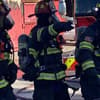Podcast
Questions and Answers
What should be included in the photograph of the DNRO documentation on the ePCR?
What should be included in the photograph of the DNRO documentation on the ePCR?
- A summary of the patient's medical history
- Only the signatures on the form
- A description of the resuscitation attempts made
- The original document's content along with any manual handwriting and background color (correct)
What must personnel do if presented with an invalid DNRO or in its absence?
What must personnel do if presented with an invalid DNRO or in its absence?
- Initiate CPR and standard life-saving techniques (correct)
- Document the invalid DNRO in the ePCR
- Consult with the legal guardian before proceeding
- Provide comfort care only
What action should be taken if it is determined that the patient has a valid DNRO after CPR has begun?
What action should be taken if it is determined that the patient has a valid DNRO after CPR has begun?
- Discontinue CPR and ensure proper documentation (correct)
- Notify family members before discontinuing CPR
- Continue CPR until emergency services arrive
- Document the CPR activities despite DNRO
Which of the following statements is accurate regarding the revocation of a DNRO?
Which of the following statements is accurate regarding the revocation of a DNRO?
What is the correct sequence of steps to add a photo of the DNRO to the ePCR?
What is the correct sequence of steps to add a photo of the DNRO to the ePCR?
What is the primary purpose of a Do Not Resuscitate Order (DNRO)?
What is the primary purpose of a Do Not Resuscitate Order (DNRO)?
Which of the following statements about a valid DNRO is incorrect?
Which of the following statements about a valid DNRO is incorrect?
In case a witness is used to confirm the identity of a patient with a DNRO, which detail is NOT required to be documented?
In case a witness is used to confirm the identity of a patient with a DNRO, which detail is NOT required to be documented?
What should be done with the DNRO form upon transporting the patient?
What should be done with the DNRO form upon transporting the patient?
Which of the following describes an acceptable format for a DNRO?
Which of the following describes an acceptable format for a DNRO?
What is a component that must be documented in the electronic Patient Care Report (ePCR) regarding the DNRO?
What is a component that must be documented in the electronic Patient Care Report (ePCR) regarding the DNRO?
What kind of care may a patient with a DNRO still receive?
What kind of care may a patient with a DNRO still receive?
Who can sign a DNRO if the patient is unable to provide consent?
Who can sign a DNRO if the patient is unable to provide consent?
Study Notes
Do Not Resuscitate Orders (DNRO) Overview
- DNROs are legal documents expressing a patient’s wish to avoid resuscitation in case of respiratory or cardiac arrest.
- The order ensures medical staff refrain from resuscitation efforts while still providing other necessary medical care.
Valid DNRO Criteria
- Must be an original or completed copy of DH Form 1896, Florida Do Not Resuscitate Order, dated December 2002.
- The form can be legally duplicated on yellow paper, ensuring quality and unaltered content.
- Previous editions of DH Form 1896 are also accepted.
- A DNRO Patient Identification Device may accompany the order, serving as a portable version of form 1896, although its use is voluntary.
- The DNRO must be signed by:
- The patient's physician.
- The patient, healthcare surrogate, court-appointed guardian, or an individual with a durable power of attorney.
Confirmation and Documentation
- Patient identity must be confirmed via photo identification or a witness, documented in the ePCR narrative.
- Required witness information includes:
- Full name, address, and telephone number of the witness.
- Relationship of the witness to the patient.
- Documentation in ePCR must include:
- Effective date of the DNRO.
- Information on any witness used.
- Name of attending physician who signed the DNRO.
- Identity of the signer (patient, surrogate, guardian, or proxy).
- Information regarding the patient's death during transport if applicable.
- A copy of the DNRO must accompany the patient if transported, with personnel relinquishing it to the receiving facility.
Photograph Documentation
- A photograph of the DNRO must be included in the ePCR, accurately reproducing the original form with all details, including yellow background.
- The process for attaching a photo involves:
- Selecting 'History' and 'Directives.'
- Adding a photo under 'Scene' with the caption 'DNRO.'
Additional Considerations
- Valid DNROs dictate that personnel should not perform CPR but may provide other medical care.
- Invalid DNROs or absence of a DNRO requires initiation of CPR and other life-saving techniques.
- If CPR begins and a valid DNRO is discovered, resuscitation efforts must cease, with proper documentation required.
- Patients, surrogates, guardians, or proxies can revoke a DNRO at any time, in accordance with section 765.104, FS.
Studying That Suits You
Use AI to generate personalized quizzes and flashcards to suit your learning preferences.
Description
Test your knowledge on Do Not Resuscitate Orders (DNRO) and their legal implications. This quiz covers the purpose, process, and considerations surrounding DNROs and how they relate to patient care. Understand the role of medical personnel when encountering such orders.





